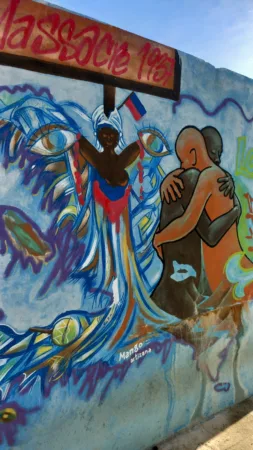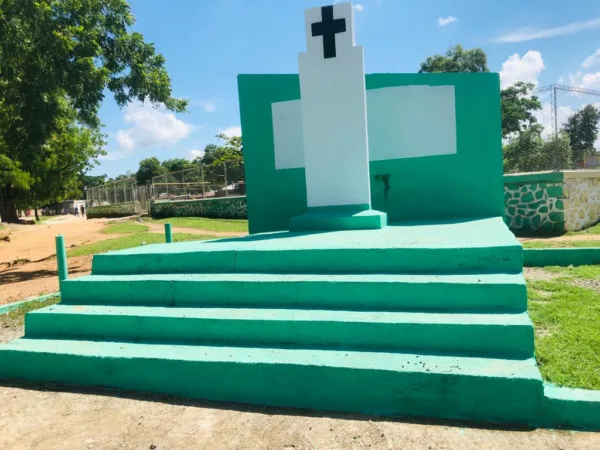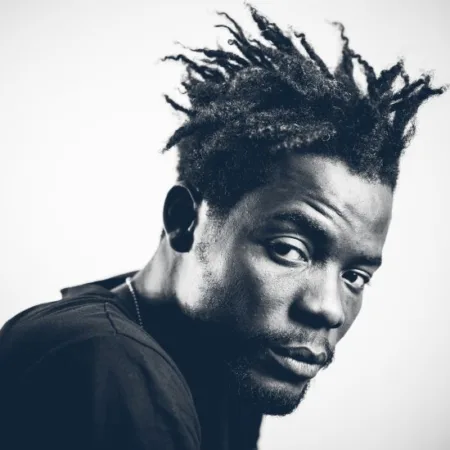This discrepancy between the Haitian director Pierre Michel Jean and the Dominican professionals opens a debate on the memorial story linked to the 1937 massacre.
In his latest documentary titled “Forgetting kills twice,” the Haitian director Pierre Michel Jean proposes to revisit, through the history of the last survivors, the 1937 massacre that occurred on the border between Haiti and the Dominican Republic, in which more than 20,000 people died.
Completed in 2022, the film could not be released on the agreed date because, according to Pierre Michel Jean, two Dominican actors who participated in the project, feminist activist Isabel Spencer and Amin Dominguez, expressed reservations regarding part of the narrative presented in the 70-minute documentary about this unfortunate historical event.
“I was hoping to have deeper discussions with them to reach an agreement, but that didn’t work,” Jean explained to AyiboPost.
A source involved in the project told AyiboPost that “the demands of the Dominican actors do not explain the delay of the film,” since they signed for the use of their images.
«The two actors, especially Isabel Spencer, an LGBTQ and Afrofeminist activist, maintain that they still carry [como dominicanos] “the weight of a heritage marked by the dark and racist past of the Trujillo dictatorship,” the source continued.
Dominican feminist activist Isabel Spencer, an actress in the film “Forgetting Kills Twice” by Haitian director Pierre Michel Jean. | © Central News
This conflict between the Haitian director Pierre Michel Jean and the Dominican professionals opens a whole debate on the historical memory of the 1937 massacre. But also on the need to think better about the relations between the two countries based on this little-known historical episode, according to specialists contacted by AyiboPost.

Amin Dominguez, a Dominican actor participating in the documentary “Forgetting kills twice” by Haitian director Pierre Michel Jean. | © Le Montro
“The 1937 massacre is shrouded in a double silence, both on the part of Haiti and the Dominican Republic,” explains Professor Jean Marie Théodat to AyiboPost.
For the geographer, on the Dominican side this silence is explained by the fact that Dominicans have difficulties in evoking this hateful event from their past. For many of them, once the Haitian State accepted compensation from the Dominican government, “it was a closed case.” And on the Haitian side, particularly the survivors, the massacre constitutes “an infamy that they do not tell their descendants.”
«As a result, dialogue between the two peoples becomes impossible. “Which leaves a shadow over the relations between both countries,” explains the author of the book. Haiti, Dominican Republic: an island for two.
Read also: Perspective | The roots of tensions between Haiti and the Dominican Republic
In recent years, memorial murals dedicated to the victims of the massacre have been vandalized by Haitians and Dominicans. Which, for Jésula Blanc, lawyer and coordinator of the Northeast gender platform, illustrates the tension that exists between Haitians and Dominicans around the memory of this massacre.

These commemorative wall paintings, near Ouanaminthe, dedicated to the victims of the Perejil massacre, have been erased by Haitian individuals in recent years.
In September 2023, in line with the conflict over canal construction In the Juana Méndez river massacre, Haitian citizens destroyed the mural erected in 2019 by the Northeast Gender Platform (PGNE) in Dosmond, not far from Ouanaminthe.
[metaslider id=55101]
«This situation, although tense, did not prevent the carrying out of the traditional commemorative activities of the massacre in October 2023», explains Jésula Blanc, who worked for the Support Group for Returnees and Refugees (GARR).
A similar case was recorded in the Dominican Republic in 2017.
A Dominican citizen presented as an “ultranationalist” destroyed another mural built by the binational organization Azuei, in Dajabón, shortly after its construction.

After Haitian individuals erased memorial murals near Ouanaminthe, dedicated to the victims of the 1937 massacre.
In October 1937, Dominican dictator Rafael Leónidas Trujillo, then president of the country, ordered the massacre of peasants living in the border areas of Dajabón and Monte Cristi. More than 20,000 people died.
What was initially presented in official Dominican speeches as a simple conflict between Dominican and Haitian peasants quickly rose to the level of genocide as the scale of the terror was revealed.
About this massacre, see this video from AyiboPost: “Knife” massacre of Haitians in Santo Domingo!
87 years later, the event is not the subject of any official commemoration by the two neighboring states.
The Perejil massacre was the largest mass killing of Afro-descendants on the American continent in the 20th century. Already in November 1937, the American newspaper New York Times reported that 8,000 people were murdered on the border by Trujillo’s henchmen.
Some counts reach up to 35,000 dead at the end of the massacre.
While part of the Haitian intellectual class speaks of a murder ordered by Trujillo against Haitians, other “moderate” researchers maintain that Dominican peasants were also murdered.
For Rachèle Magloire, filmmaker and president of the Haitian branch of the Azuei organization, one of the fundamental problems that raises so much controversy when addressing the issue of the massacre is the lack of knowledge about the event in Haiti.
87 years later, the event does not have official recognition from the two neighboring States.
For Magloire, we cannot speak of Parsley as a massacre perpetrated only against Haitians.
“It was actually a massacre against Haitians and Dominicans of Haitian descent, orchestrated by Trujillo as part of his macabre project of ethnic cleansing,” explains the director of the documentary. Kamoken Cemetery.
On the other hand, other works insist on the use of the word Parsley (persil in French) to show that there was indeed a concern to differentiate between Haitians and Dominicans during the massacre.
According to historians, before the massacre on the border, friendly and commercial relations developed between the two peoples without many incidents.
But Trujillo’s anti-Haitian propaganda and his desire to “whiten” the Dominican nation would change everything.
“The history of relations between the two countries is full of ups and downs,” explains Magloire.
In 1937 an agreement was reached between the Haitian and Dominican governments. In this agreement, the Dominican government agreed to pay the Haitian State the sum of 750,000 US dollars to compensate the families of the victims.
Of this sum, only $525,000 was disbursed. But the Haitian State never paid this money to the families of the victims and, on the Dominican side, no official from the Trujillo government was convicted.
Sténio Vincent’s decision to accept this “derisory” compensation on behalf of the victims has been described by some as a disgraceful agreement.
Stenio Vincent, then president, even went so far as to ban any demonstration aimed at demanding justice for the victims. The former ambassador of Haiti to the Dominican Republic (2020-2022), Smith Augustin, also recognizes the delicacy that surrounds the evocation between Haitians and Dominicans of this massacre.
But for the former ambassador and sociologist, the issue of silence around 1937 lies mainly on the Haitian side. «This is a topic that is rarely mentioned in Haitian school textbooks, but is very present in the imagination of Dominicans. Even at the University of Haiti we only talk vaguely about it,” explains Agustín, who says he observes “an academic void” that would allow us to clearly identify the complexity of the relations between Haiti and the Dominican Republic from Haiti, particularly in this context, which refers to the massacre and other more recent events.
Haitian essayists such as Jean Price Mars, Suzy Castor, Leslie F. Manigat and, in fiction, Jacques S. Alexis, René Philoctète, Edwidge Danticat are among the Haitian authors who have been interested in the issue.
This is a topic that is rarely mentioned in Haitian school textbooks, but is very present in the imagination of Dominicans. Even at the university in Haiti we only vaguely talked about it
On the Dominican Republic side there are Bernardo Vega, Freddy Prestor Castillo, Elissa L. Lister, Hayden Carrón, etc.
«We need a history chair at the university of Haiti on the relations between Haiti and the Dominican Republic. “This way we can address these complex issues,” suggests Augustin.
For the Belgian anthropologist Catherine Bourgeois, who did her thesis on Haitian-Dominican relations, there is a memory of the events of 1937 in the Dominican Republic, but for her it is a “very fragmentary” memory.
Bourgeois talks about the difficulties encountered in 2008 in completing his thesis.
«It is very difficult to build a complete picture of the events, given that the people who witnessed them directly are already dead. And their descendants don’t talk much about it,” explains Bourgeois.
However, for the anthropologist who spent four years in this country conducting her research, although Dominicans find it difficult to talk about the 1937 massacre, they do not find it difficult to talk about other atrocities committed by the Trujillo dictatorial regime, such as the executions of opposition politicians, etc.
“The massacre of 1937 is a memory manipulated and repressed by the dictatorship established by Trujillo,” explains Bourgeois.
The simple act of talking about the Perejil massacre sometimes generates discord in binational meetings.
«It is so recurrent that I am less and less interested in participating in bilateral meetings. “I no longer believe in that,” declares Jésula Blanc, lawyer and coordinator of the Northeast gender platform.
Read also: Opinion | A new massacre of Haitians in the DR is not improbable. Here’s what can stop it.
Dominican public opinion is divided on a position on the events that occurred in 1937.
In October 2007, during a solemn mass in the parish of Dajabón, the bishop of the diocese of Mao-Montecristi, Diómedes Espinal de León, aroused strong reactions in the Dominican Republic when he asked for forgiveness from the Haitian people for the atrocities committed by Trujillo in 1937. .
Dominican personalities, among them Cardinal Jesús López Rodríguez, reacted by stating that it is not up to the Dominicans to ask for forgiveness from the Haitian people, because “it is a crime for which only Trujillo is responsible and not the Dominican people.”
Dominican public opinion is divided on a position on the events that occurred in 1937.
Also in the history of relations between Haiti and the Dominican Republic is the massacre known as the Moca massacre, described by some as one of the deadliest and bloodiest Haitian invasions led by Jean-Jacques Dessalines in 1805.
For Dominicans, we cannot talk about the massacre of 1937 without remembering the Moca massacre, perpetrated by troops led by Jean-Jacques Dessalines and Henry Christophe in April 1805 in this small town called Moca located in the Cibao valley, in Dominican Republic.
This massacre, for them, is a testimony of the atrocity that they suffered. in the hands of the Haitians in 1805.
In 1804, after having expelled the French from Haiti, the latter, led by General Jean-Louis Ferrand, took refuge in the eastern part of the island. At the head of his troops, Dessalines undertook an offensive against these French forces. But this offensive ended in failure.
Upon returning home, Dessalines’ troops massacred hundreds of civilians in the town of Moca.
For Dominicans, we cannot talk about the massacre of 1937 without remembering the Moca massacre, perpetrated by troops led by Jean-Jacques Dessalines and Henry Christophe in April 1805.
For some intellectuals, such as Jean-Marie Théodat, both events are not equivalent.
«The first, in 1805, we found ourselves in a dynamic of decolonization of the entire island undertaken by Dessalines, while the second, in 1937, was about ethnic cleansing. These are, therefore, two different events,” says the professor.
No historical fact should be taboo, historians maintain.
“On both sides of the island, we need leaders who are aware of the complexity of relationships in order to manage them,” suggests Théodat.
Read also: The exploitation of a gold mine on the border between Haiti and the DR is scary
Regarding the conflict surrounding his latest film, Pierre Michel Jean declares that he trusted the historical data available about the 1937 massacre.

Photo by Pierre Michel Jean
“I believe I have produced a film that allows us to revisit this dark and thorny episode in the history of relations between the two countries,” says Jean. “Now it is up to historians and politicians to advance the debate on the issue,” he concludes to AyiboPost.
Par Wethzer Piercin
Translation into Spanish by Marcela Alfonsina Colocho Rodriguez
Cover image : Riquemi Perez
Watch our special report published in January 2022 on the start of the canal construction initiative in the Rivière Massacre:










